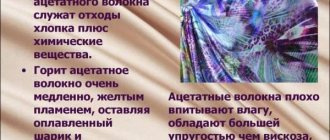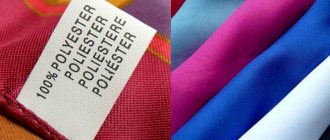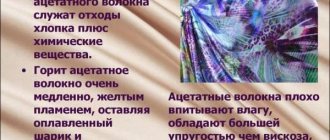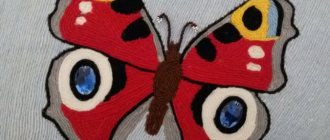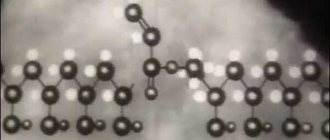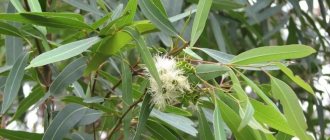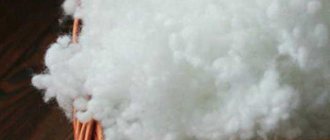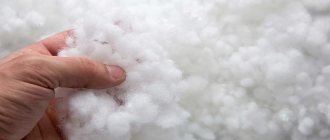tags:
Nylon, Production, Fiber, Caprolactam, Caproamide, Processing, Use, Directly Heterochain fibers are the main class of synthetic fibers that are most widely used. On an industrial scale, mainly two types of heterochain fibers are produced - polyamide and polyester.
The greatest distribution of polyamide fibers is explained by their inherent valuable properties and the wide raw material base for their production. Also largely due to the fact that methods for obtaining source materials, as well as molding and subsequent processing processes, were developed for polyamide fibers earlier and in more detail than for other heterochain fibers.
Capron (poly-e-caproamide, nylon-6, polyamide-6) is a synthetic heterochain polyamide fiber constructed from e-aminocaproic acid residues.
nylon fiber polyamide
Nylon is a white-transparent solid, very durable substance, the molecular weight depends on the conditions for obtaining this polymer and lies in the range of 10 4 -3.5 * 104. Used for molding nylon fiber.
The elasticity of nylon fiber is much higher than silk. Strength depends on technology and careful production. A nylon thread with a diameter of 0.1 millimeter can withstand 0.55 kilograms.
Along with high strength, nylon fibers are characterized by high chemical and wear resistance, are resistant to repeated deformation (bending), to the action of most solvents, and are easy to dye.
They are harmless and indifferent to animal tissues, enzymes and bacteria, as a result of which they do not dissolve in the body.
Nylon fibers do not absorb moisture, so they do not lose strength when wet. But nylon fiber also has disadvantages. It is not very resistant to acids - nylon macromolecules undergo hydrolysis at the site of amide bonds. The heat resistance of nylon is also relatively low. When heated, its strength decreases and melting occurs at 215 °C.
POLYAMIDE FIBERS
molded from melts of aliphatic polyamides. Available in the form of continuous threads and staple fiber (linear density 1.7-187.0 tex), as well as monofilament. They are characterized by high strength (300-900 mN/tex with a relative elongation of 13-65%), elasticity, fatigue endurance, wear resistance, good resistance to impact loads, a relatively low elastic modulus, low hygroscopicity (the reason for increased electrification), light and heat resistance (max. . operating temperature 80-150 ° C. Resistant to alkali solutions (at normal temperatures), aliphatic alcohols, acetone, CCl4, hydrocarbons, ethers; soluble in concentrated mineral acids, phenols, CHCl3, nitrobenzene, dimethylacetamide, DMF, some fluorinated alcohols and organic acids. Dyeing - surface and in bulk, mainly with dispersed and acid dyes. Used for the manufacture of consumer goods, copying materials, fishing nets, ropes, bristles, etc. See also Polycaproamide fiber.
Application of lavsan
Currently, PET-based materials can be classified as the most widespread types of polymers.
They are used to make plastic containers for a wide variety of purposes, including food containers, bottles, and packaging film. Until recently, lavsan was widely used as a base for technical films for:
- reflective coatings;
- x-rays and photographs;
- films;
- sound recordings;
- floppy disks, etc.
Mylar threads are used in surgical practice, and sheets and film that transmit light and UV radiation are used for the construction of greenhouses, agricultural and construction needs. Cast lavsan structures, which have strength and electrical insulating properties, are used in electrical engineering, radio electronics, and instrument making. Mylar fibers are used as a reinforcing material, primarily for tires and cord materials; they are used to make technical fabrics for hoses and conveyors. And, of course, lavsan is used to make textiles.
Fabrics based on lavsan are made using the plain weave method. Outwardly, they resemble linen, but are more rigid. They are used primarily for workwear, as they provide good protection against fire and exposure to chemical reagents. Another wide area where lavsan fabric is used is the production of inexpensive and durable curtains that are easy to care for and resistant to sunlight. This tough and well-structured textile is appreciated by needlewomen, because in appearance it is almost no different from linen matting, but it costs much less and does not wrinkle during work. As for household materials, lavsan is used as an additive to wool and viscose. Such budget fabrics are well suited for casual and work wear, including office wear. They are durable and wear for a long time, do not wrinkle, and the folds placed on them do not straighten out even after washing. A more modern type of PET fiber is polyester. It has the same composition as lavsan, but the technology for its production makes it possible to create a thinner and smoother fiber with a more pleasant tactile sensation.
Caring for lavsan materials is very simple. They can be washed in any mode (preferably without bleaches), straightened out well when drying, and ironed in the “Synthetic” mode.
POLYAMIDES
polymers containing amide groups —CO—NH— in the main chain of the macromolecule. The most important ones are the general formulas [—HNRNHOCR'CO—]n and [—HNR»CO—]n, where R, R'= Alk, Ar, R" = Alk. Thermoplastics. The molecular weight is usually 10-30 thousand, density 1.02-1.35 g/cm3, macromolecules are connected to each other by hydrogen bonds, which causes relatively high melting temperatures of P. The maximum degree of crystallinity is 40-70%. Dissolves in highly polar solvents (eg concentrated H2SO4, COOH, cresols), dimethylacetamide, insoluble in water; resistant to oils, gasoline, diluted and concentrated alkali solutions, dilute acids. At elevated temperatures they are destroyed by acids, alkalis, and amines. They are characterized by high wear resistance, low coefficient of friction, good electrical insulation and strength properties. The hydrogen of the amide group can be replaced by alkyl and other radicals; Substituted P. have a low degree of crystallinity and relatively low melting points. Preparation: polycondensation of dicarboxylic acids (or their esters, dichlorides) with diamines; polymerization of lactams. Mainly used in the production of fibers, films, structural, electrical insulation and household products; adhesive base. See, for example, Poly-ε-caproamide.
Stages of nylon production
As a rule, nylon is produced directly at synthetic fiber factories. Therefore, such production represents a single technological cycle, including the following stages:
- preparation of raw materials (melting the monomer, preparing an aqueous solution of the catalyst);
- polymerization of caprolactam;
- polymer processing (cooling and obtaining polymer tape, its crushing and drying);
- obtaining a melt of polye-caproamide and spinning the fiber.
The raw materials for the production of nylon are phenol, benzene, toluene or cyclohexane, obtained from coal or oil. Currently, the most developed method is the industrial production of nylon from phenol. Phenol is converted into caprolactam (monomer) by a series of chemical reactions, which is then converted into nylon by polymerization.
2 pages, 798 words
General rules for conducting investigative actions
...psychiatrist, head injury; the nature of the crime committed; the presence of signs of affect in a person’s actions; inappropriate behavior of a person during investigative actions; stated reasoned request of the defense lawyer. The system of measures should be expanded, ... without a break for more than 2 hours, and in total - more than 4 hours a day.” would be that actions fulfill their own and each has its own meaning, its own...
Caprolactam can be obtained, for example, during the Beckman rearrangement:
Caprolactam is supplied to synthetic fiber factories in plastic bags or in paper bags placed in bags made of rubberized fabric. It is also transported in a molten state in special tanks covered with thermal insulation and equipped with a coil for steam heating. When transporting caprolactam melt, a significant economic effect is achieved, since the operation of melting caprolactam at the consumer plant is eliminated and contamination of the product is eliminated. Melted caprolactam can be stored in heated and insulated containers.
The polymerization process of caprolactam—the transformation of rings into linear polymers—is called polyamidation. It occurs only at a relatively high temperature and elevated, normal or reduced pressure in the presence of an activator.
Activators can be organic or mineral acids, as well as water, AG salt (a product of the interaction of equimolecular quantities of adipic acid and hexamethylenediamine [HOOC(CH 2 )4 COOH-NH2 (CH2 )6 NH2 ]), aminocaproic acid or other compounds that, under conditions In the process of caprolactam polyamidation, they are capable of undergoing chemical transformations with the release of water.
In addition to the listed compounds, alkalis and metallic sodium are very effective activators, which reduce the duration of the polyamidation reaction by tens and hundreds of times. Under production conditions, water is most often used as an activator for the caprolactam polyamidation process.
The reaction mechanism for the formation of poly-e-caproamide depends on the nature of the activator used. In the presence of water, the polyamidation reaction of caprolactam proceeds stepwise according to the following scheme:
At the initial stage of the process, when caprolactam reacts with water, aminocaproic acid is formed:
Aminocaproic acid combines with a caprolactam molecule and a dimer is formed:
The dimer interacts with another caprolactam molecule and a trimer is formed:
The addition of caprolactam molecules occurs before the formation of poly-e-caproamide:
The polyamidation reaction of caprolactam is equilibrium and reversible:
In this regard, caprolactam is not completely converted into poly-e-caproamide and the polymer always contains a certain amount (about 10%) of monomer and low molecular weight water-soluble compounds (dimer, trimer and caprolactam), which can be removed by washing with hot water or distillation under vacuum from molten polymer.
Poly-e-caproamide intended for processing into nylon fiber has certain requirements. In particular, it must have a sufficiently large molecular weight (not lower than 10 4) and be monolithic, i.e. do not contain a large number of voids and cavities. In addition, the polymer should not contain oxidation products (white poly-e-caproamide).
12 pp., 5999 words
Classification of textile fibers and threads
... copper, aluminum and other fibers). Textile thread is a flexible and durable body with small transverse dimensions of considerable length. textile fiber yarn density There are initial, ... complex of a large number of longitudinally folded elementary chemical threads intended for the manufacture of yarn. 3. STRUCTURE OF FIBERS Textile fibers consist of macromolecules that have a large molecular...
To avoid oxidation of the molten poly-e-caproamide, the process is carried out in an atmosphere of nitrogen supplied to the equipment at the stage of melting and polymerization of the monomer.
POLY-ε-CAPROAMIDE
(polyamide-6, nylon, perlon, silone, etc.) [—HN(CH2)5CO—]n, thermoplastic; Molecular weight 10-15 thousand; density 1.13-1.15 g/cm3; pl 225°C, size 210°C, hr from -25 to -30°C, degree of crystallinity up to 60%; dissolves in concentrated H2SO4, HCOOH; stable in oils, gasoline, concentrated and diluted alkali solutions and dilute acids. Self-extinguishing; strength 60-70 MPa, bending 90 MPa, impact strength 150 kJ/m2, elongation 150-400%, v 2·1014 Ohm m; maximum water absorption 8-12%. Preparation: polymerization of ε-caprolactam. It is mainly used in the production of fibers, as well as films, bearings, gears and worm wheels, bushings and other machine parts, electrical insulating and household products.
Kapron: properties and application
In appearance, nylon is a material with a transparent to yellowish tint. The material has a slight shine. This is a thin but dense fabric.
Nylon cord thread
Nylon has properties such as strength, wear resistance and lightness. Dirt does not stick to it, does not change under the influence of water, is lightweight and easy to maintain. Items made from nylon fiber can be subjected to physical impact. For example, squeeze. But when scratched with a sharp object, the fiber is easily damaged.
Melting threads
The composition is not susceptible to the pathogenic effects of microorganisms. The fiber made from nylon does not absorb moisture, but when washed at too high temperatures it can lose its shape. The density of nylon may vary. The material cannot burn: it simply melts, forming a resinous substance.
Interesting fact. After graduation, it received the “title” of the strongest material, displacing silk from there.
Where is nylon used?
Nylon fabric is widely used and is common in the textile industry. Typically, the range of clothing produced is expanded through the production of mixed fabric. This is achieved by adding other materials to the main fabric tape, such as silk or viscose (raincoat version).
Nylon is a polymer used in the production of automobile and sporting goods, for example, the well-known tires. The filter fabrics required in production are also produced using nylon fabric.
You might be interested in What is technical felt: characteristics of a sheet building material
Nylon mesh
A large number of household goods needed are made from it. The use of nylon is reflected in the following products: cables, nets, fishing lines, ropes, curtains, tulle and medical consumables. Medical clothing and professional uniforms are often also produced thanks to nylon compounds. The most widespread are nylon tights, accessories, as well as elements in clothing where it is necessary to make any part of the body transparent.
Additional Information. Now curtains made of nylon fiber are not popular. The main role of the material in the production of curtains is reduced to external decoration.
POLYCAPROMIDE FIBER
(nylon, amylan, dederon, nylon-6, perlon, stylon, etc.), molded from a melt of poly-ε-caproamide.
Available in the form of continuous thread and staple fiber; linear density 1.7-187.0 tex. Low stability in concentrated acids and alkali solutions, mold-resistant, not destroyed by moths and termites. Strength 400-900 mN/tex, relative elongation 14-60%. It is used in the production of cord threads and fabrics for tires and rubber goods (for example, conveyor belts), clothing fabrics, knitwear, carpets, etc. See also Polyamide fibers. *Materials are printed based on the book: Chemical Encyclopedic Dictionary. Ch. ed. I.L. Knunyants. – M., Publishing House “Soviet Encyclopedia”, 1983. – 792 p.
up
History of creation
Nylon is a type of fiber obtained as a result of an experiment by German scientists. Polycaprolactam was originally developed. In 1938, the first positive results on synthesis appeared, and 5 years later industrial production began.
Material close up
Nylon fiber had a serious drawback - it was coarse. Because of this, the material was used more as an auxiliary element in production. Then Soviet scientists supplemented the experiment with some developments. This is how this polyamide was synthesized.
Thanks to the discovery, polycaproamide fiber was produced, and then aminocaproic acid was added to it. In Germany, a product with similar characteristics was developed, called perlon. Also in other countries the fabric is known as nylon or dederon.
Industrial production of material
This is interesting. Producing nylon will cost several times less than producing cotton.
Kapron or copron - since we are talking about the reaction of caprolactam, it is correct to say nylon.
Care
For nylon, as for any other fabric, proper care is important:
- It is not recommended to wash this type of fabric at high temperatures. For washing, use the delicate cycle. Housewives recommend using a temperature of no more than 30 °C. But at 40 °C, nylon items also do not lose their positive qualities.
- You should not use bleach when washing; if necessary, just soak the item in soapy water.
- Be sure to ensure that the powder dissolves as much as possible.
- The item must be well rinsed, otherwise the product will lose color and brightness.
- The fabric is not spun or ironed. If it is necessary to iron the material, use low temperatures.
- If the item becomes dusty, it is best to use a vacuum cleaner.
- Avoid touching things with sharp objects.
Nylon tights

